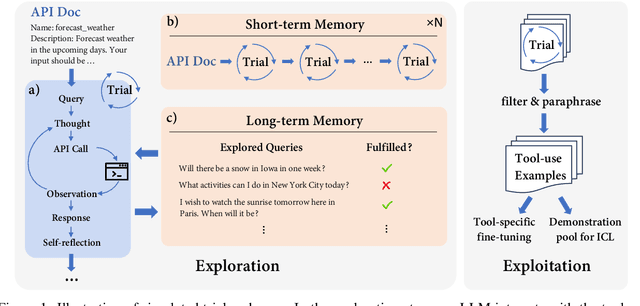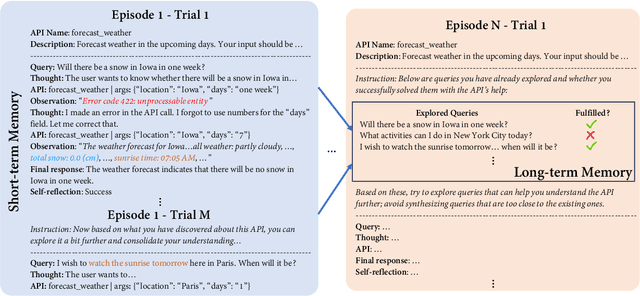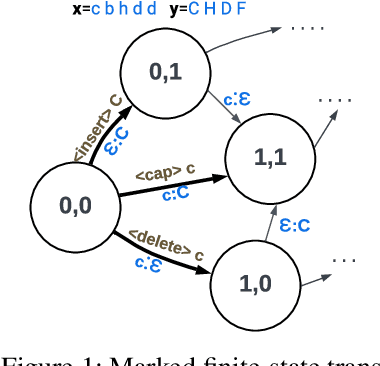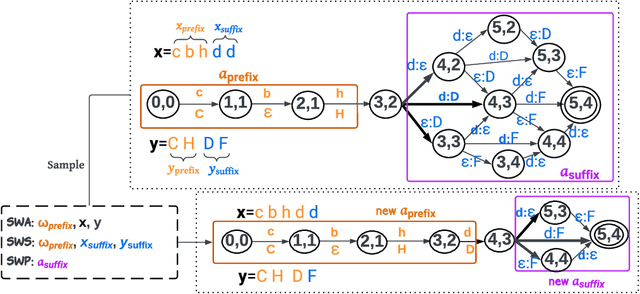Jason Eisner
University of Rochester
MICE for CATs: Model-Internal Confidence Estimation for Calibrating Agents with Tools
Apr 28, 2025Abstract:Tool-using agents that act in the world need to be both useful and safe. Well-calibrated model confidences can be used to weigh the risk versus reward of potential actions, but prior work shows that many models are poorly calibrated. Inspired by interpretability literature exploring the internals of models, we propose a novel class of model-internal confidence estimators (MICE) to better assess confidence when calling tools. MICE first decodes from each intermediate layer of the language model using logitLens and then computes similarity scores between each layer's generation and the final output. These features are fed into a learned probabilistic classifier to assess confidence in the decoded output. On the simulated trial and error (STE) tool-calling dataset using Llama3 models, we find that MICE beats or matches the baselines on smoothed expected calibration error. Using MICE confidences to determine whether to call a tool significantly improves over strong baselines on a new metric, expected tool-calling utility. Further experiments show that MICE is sample-efficient, can generalize zero-shot to unseen APIs, and results in higher tool-calling utility in scenarios with varying risk levels. Our code is open source, available at https://github.com/microsoft/mice_for_cats.
Syntactic and Semantic Control of Large Language Models via Sequential Monte Carlo
Apr 18, 2025



Abstract:A wide range of LM applications require generating text that conforms to syntactic or semantic constraints. Imposing such constraints can be naturally framed as probabilistic conditioning, but exact generation from the resulting distribution -- which can differ substantially from the LM's base distribution -- is generally intractable. In this work, we develop an architecture for controlled LM generation based on sequential Monte Carlo (SMC). Our SMC framework allows us to flexibly incorporate domain- and problem-specific constraints at inference time, and efficiently reallocate computational resources in light of new information during the course of generation. By comparing to a number of alternatives and ablations on four challenging domains -- Python code generation for data science, text-to-SQL, goal inference, and molecule synthesis -- we demonstrate that, with little overhead, our approach allows small open-source language models to outperform models over 8x larger, as well as closed-source, fine-tuned ones. In support of the probabilistic perspective, we show that these performance improvements are driven by better approximation to the posterior distribution. Our system builds on the framework of Lew et al. (2023) and integrates with its language model probabilistic programming language, giving users a simple, programmable way to apply SMC to a broad variety of controlled generation problems.
Fast Controlled Generation from Language Models with Adaptive Weighted Rejection Sampling
Apr 07, 2025Abstract:The dominant approach to generating from language models subject to some constraint is locally constrained decoding (LCD), incrementally sampling tokens at each time step such that the constraint is never violated. Typically, this is achieved through token masking: looping over the vocabulary and excluding non-conforming tokens. There are two important problems with this approach. (i) Evaluating the constraint on every token can be prohibitively expensive -- LM vocabularies often exceed $100,000$ tokens. (ii) LCD can distort the global distribution over strings, sampling tokens based only on local information, even if they lead down dead-end paths. This work introduces a new algorithm that addresses both these problems. First, to avoid evaluating a constraint on the full vocabulary at each step of generation, we propose an adaptive rejection sampling algorithm that typically requires orders of magnitude fewer constraint evaluations. Second, we show how this algorithm can be extended to produce low-variance, unbiased estimates of importance weights at a very small additional cost -- estimates that can be soundly used within previously proposed sequential Monte Carlo algorithms to correct for the myopic behavior of local constraint enforcement. Through extensive empirical evaluation in text-to-SQL, molecular synthesis, goal inference, pattern matching, and JSON domains, we show that our approach is superior to state-of-the-art baselines, supporting a broader class of constraints and improving both runtime and performance. Additional theoretical and empirical analyses show that our method's runtime efficiency is driven by its dynamic use of computation, scaling with the divergence between the unconstrained and constrained LM, and as a consequence, runtime improvements are greater for better models.
LLM-Rubric: A Multidimensional, Calibrated Approach to Automated Evaluation of Natural Language Texts
Dec 31, 2024Abstract:This paper introduces a framework for the automated evaluation of natural language texts. A manually constructed rubric describes how to assess multiple dimensions of interest. To evaluate a text, a large language model (LLM) is prompted with each rubric question and produces a distribution over potential responses. The LLM predictions often fail to agree well with human judges -- indeed, the humans do not fully agree with one another. However, the multiple LLM distributions can be $\textit{combined}$ to $\textit{predict}$ each human judge's annotations on all questions, including a summary question that assesses overall quality or relevance. LLM-Rubric accomplishes this by training a small feed-forward neural network that includes both judge-specific and judge-independent parameters. When evaluating dialogue systems in a human-AI information-seeking task, we find that LLM-Rubric with 9 questions (assessing dimensions such as naturalness, conciseness, and citation quality) predicts human judges' assessment of overall user satisfaction, on a scale of 1--4, with RMS error $< 0.5$, a $2\times$ improvement over the uncalibrated baseline.
* Updated version of 17 June 2024
Let's Think Var-by-Var: Large Language Models Enable Ad Hoc Probabilistic Reasoning
Dec 03, 2024Abstract:A hallmark of intelligence is the ability to flesh out underspecified situations using "common sense." We propose to extract that common sense from large language models (LLMs), in a form that can feed into probabilistic inference. We focus our investigation on $\textit{guesstimation}$ questions such as "How much are Airbnb listings in Newark, NJ?" Formulating a sensible answer without access to data requires drawing on, and integrating, bits of common knowledge about how $\texttt{Price}$ and $\texttt{Location}$ may relate to other variables, such as $\texttt{Property Type}$. Our framework answers such a question by synthesizing an $\textit{ad hoc}$ probabilistic model. First we prompt an LLM to propose a set of random variables relevant to the question, followed by moment constraints on their joint distribution. We then optimize the joint distribution $p$ within a log-linear family to maximize the overall constraint satisfaction. Our experiments show that LLMs can successfully be prompted to propose reasonable variables, and while the proposed numerical constraints can be noisy, jointly optimizing for their satisfaction reconciles them. When evaluated on probabilistic questions derived from three real-world tabular datasets, we find that our framework performs comparably to a direct prompting baseline in terms of total variation distance from the dataset distribution, and is similarly robust to noise.
Learning to Retrieve Iteratively for In-Context Learning
Jun 20, 2024Abstract:We introduce iterative retrieval, a novel framework that empowers retrievers to make iterative decisions through policy optimization. Finding an optimal portfolio of retrieved items is a combinatorial optimization problem, generally considered NP-hard. This approach provides a learned approximation to such a solution, meeting specific task requirements under a given family of large language models (LLMs). We propose a training procedure based on reinforcement learning, incorporating feedback from LLMs. We instantiate an iterative retriever for composing in-context learning (ICL) exemplars and apply it to various semantic parsing tasks that demand synthesized programs as outputs. By adding only 4M additional parameters for state encoding, we convert an off-the-shelf dense retriever into a stateful iterative retriever, outperforming previous methods in selecting ICL exemplars on semantic parsing datasets such as CalFlow, TreeDST, and MTOP. Additionally, the trained iterative retriever generalizes across different inference LLMs beyond the one used during training.
LLMs in the Imaginarium: Tool Learning through Simulated Trial and Error
Mar 07, 2024



Abstract:Tools are essential for large language models (LLMs) to acquire up-to-date information and take consequential actions in external environments. Existing work on tool-augmented LLMs primarily focuses on the broad coverage of tools and the flexibility of adding new tools. However, a critical aspect that has surprisingly been understudied is simply how accurately an LLM uses tools for which it has been trained. We find that existing LLMs, including GPT-4 and open-source LLMs specifically fine-tuned for tool use, only reach a correctness rate in the range of 30% to 60%, far from reliable use in practice. We propose a biologically inspired method for tool-augmented LLMs, simulated trial and error (STE), that orchestrates three key mechanisms for successful tool use behaviors in the biological system: trial and error, imagination, and memory. Specifically, STE leverages an LLM's 'imagination' to simulate plausible scenarios for using a tool, after which the LLM interacts with the tool to learn from its execution feedback. Both short-term and long-term memory are employed to improve the depth and breadth of the exploration, respectively. Comprehensive experiments on ToolBench show that STE substantially improves tool learning for LLMs under both in-context learning and fine-tuning settings, bringing a boost of 46.7% to Mistral-Instruct-7B and enabling it to outperform GPT-4. We also show effective continual learning of tools via a simple experience replay strategy.
Principled Gradient-based Markov Chain Monte Carlo for Text Generation
Dec 29, 2023Abstract:Recent papers have demonstrated the possibility of energy-based text generation by adapting gradient-based sampling algorithms, a paradigm of MCMC algorithms that promises fast convergence. However, as we show in this paper, previous attempts on this approach to text generation all fail to sample correctly from the target language model distributions. To address this limitation, we consider the problem of designing text samplers that are faithful, meaning that they have the target text distribution as its limiting distribution. We propose several faithful gradient-based sampling algorithms to sample from the target energy-based text distribution correctly, and study their theoretical properties. Through experiments on various forms of text generation, we demonstrate that faithful samplers are able to generate more fluent text while adhering to the control objectives better.
Do Androids Know They're Only Dreaming of Electric Sheep?
Dec 28, 2023Abstract:We design probes trained on the internal representations of a transformer language model that are predictive of its hallucinatory behavior on in-context generation tasks. To facilitate this detection, we create a span-annotated dataset of organic and synthetic hallucinations over several tasks. We find that probes trained on the force-decoded states of synthetic hallucinations are generally ecologically invalid in organic hallucination detection. Furthermore, hidden state information about hallucination appears to be task and distribution-dependent. Intrinsic and extrinsic hallucination saliency varies across layers, hidden state types, and tasks; notably, extrinsic hallucinations tend to be more salient in a transformer's internal representations. Outperforming multiple contemporary baselines, we show that probing is a feasible and efficient alternative to language model hallucination evaluation when model states are available.
Structure-Aware Path Inference for Neural Finite State Transducers
Dec 21, 2023



Abstract:Neural finite-state transducers (NFSTs) form an expressive family of neurosymbolic sequence transduction models. An NFST models each string pair as having been generated by a latent path in a finite-state transducer. As they are deep generative models, both training and inference of NFSTs require inference networks that approximate posterior distributions over such latent variables. In this paper, we focus on the resulting challenge of imputing the latent alignment path that explains a given pair of input and output strings (e.g., during training). We train three autoregressive approximate models for amortized inference of the path, which can then be used as proposal distributions for importance sampling. All three models perform lookahead. Our most sophisticated (and novel) model leverages the FST structure to consider the graph of future paths; unfortunately, we find that it loses out to the simpler approaches -- except on an artificial task that we concocted to confuse the simpler approaches.
 Add to Chrome
Add to Chrome Add to Firefox
Add to Firefox Add to Edge
Add to Edge